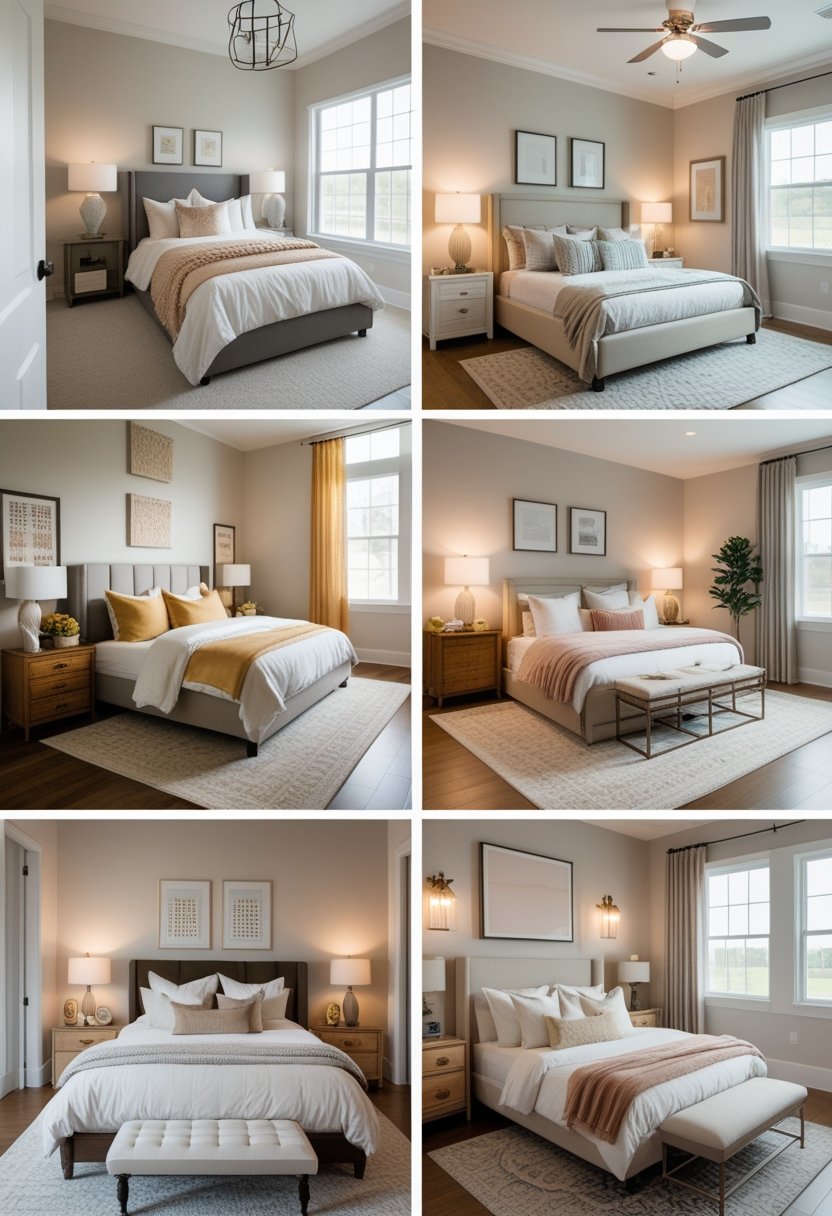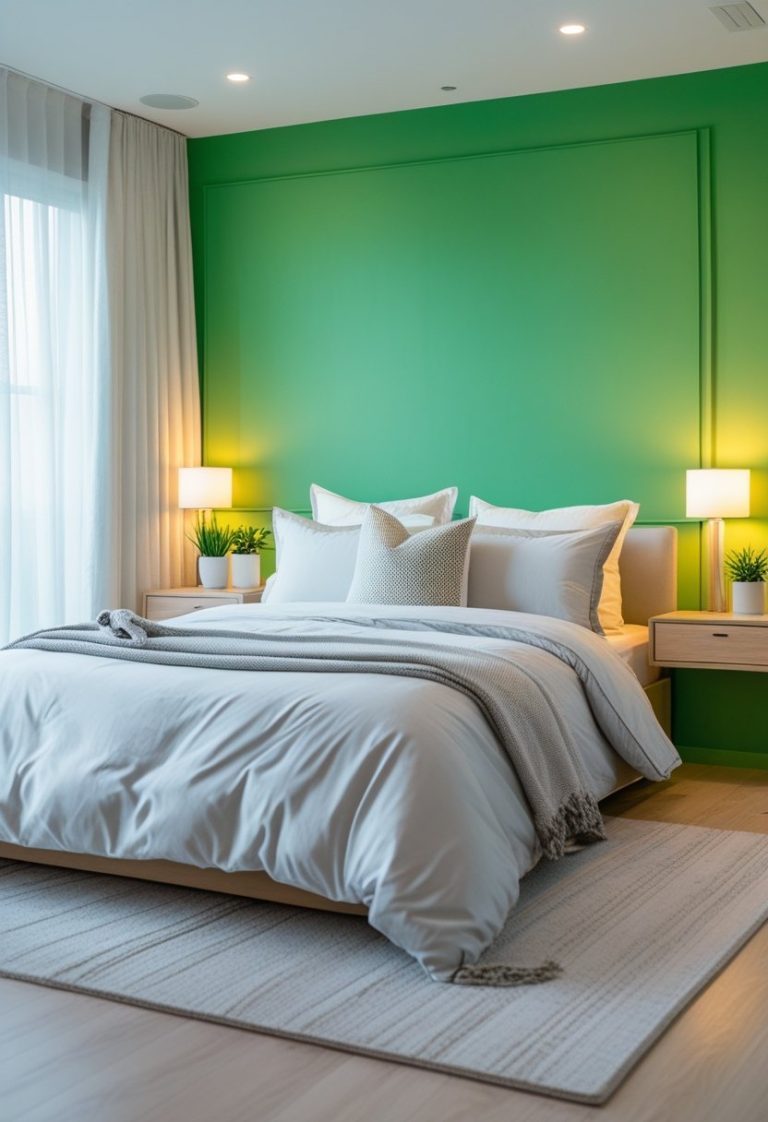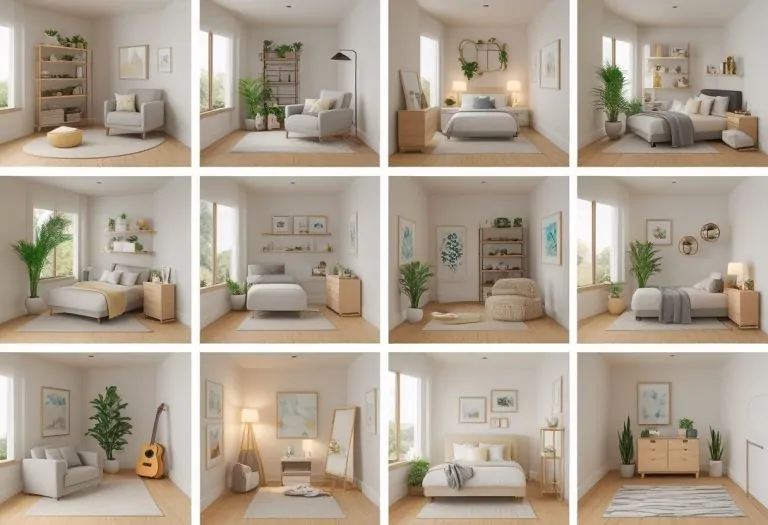Cozy Bedroom Ideas with Warm Tones, Storage & Natural Style
This collage features six bedroom designs that balance style and comfort through thoughtful layouts and decor choices. Each room emphasizes warm, earthy tones and natural textures, creating inviting spaces that feel both cozy and sophisticated. The designs use neutral color palettes, clever storage, minimalist furniture, and natural light to maximize space and maintain an airy atmosphere.

Smart solutions like built-in drawers under the bed and clean-lined furniture keep these bedrooms clutter-free without sacrificing warmth. Layered textiles such as blankets and throws add softness and depth, while carefully selected wall art, shelving, and plants introduce personality without overwhelming the space.
These bedrooms demonstrate how combining practical design with natural elements can transform a personal retreat. The interplay of light, texture, and layout serves as inspiration for creating a stylish and comfortable environment tailored to different needs.
Overview of Six Cozy and Stylish Bedroom Collage Designs

These six bedroom designs present a thoughtful mix of warmth and style. Each design incorporates key details like natural materials, efficient layouts, and subtle decor accents. Together, they demonstrate how to balance comfort and practical living in small or medium-sized spaces.
Key Features of Each Bedroom Design
Every bedroom centers around warm, earthy tones, from soft beiges to muted greens and browns. This color choice creates an inviting atmosphere and visually connects natural elements.
Storage is cleverly integrated with built-in drawers under beds or discreet shelving units. Such solutions help maintain clutter-free environments without sacrificing design.
Furniture picks are minimalist and functional, featuring clean lines and light wood finishes. Beds, desks, and chairs take a simple form, emphasizing spaciousness.
Textiles like plush blankets, layered pillows, and knitted throws provide tactile warmth while keeping the look simple. Some designs include wall collages or framed art placed strategically to add personality without visual chaos.
Unifying Aesthetic Elements
Across all six rooms, a neutral and light color palette is prominent. Whites, creams, and soft grays enhance natural daylight, which floods the rooms through large windows accompanied by sheer curtains or no treatments at all.
Natural textures are consistent: woven baskets, linen fabrics, and wooden furniture unify the spaces. These materials ground the rooms in a cozy, organic feel.
Plants and subtle art pieces complement the aesthetic. Wall collages featuring personal photos, postcards, or minimalist prints create a focal point without overwhelming walls. This layered but restrained approach balances warmth with simplicity.
Layout Diversity Among the Bedrooms
The layouts vary from compact, efficient configurations to more open, relaxed arrangements. Some designs place beds against a wall with adjacent storage; others center the bed while using vertical shelving for extra space.
One room maximizes corner space by integrating a small workspace with floating shelves overhead. Another design uses asymmetrical framing for the wall collage, increasing visual interest without disrupting flow.
Each layout thoughtfully uses natural lighting and circulation paths, ensuring areas feel breathable despite limited square footage. This careful planning pairs style with function across all designs.
Earthy and Neutral Color Palettes for a Cozy Vibe

Warm browns, muted greens, soft beiges, and gentle greys form the foundation of cozy bedroom color schemes. These colors help establish a calm and inviting environment by balancing warmth and lightness.
Choosing Warm Tones for Bedrooms
Warm tones like rich browns, terracotta, and deep taupes create a sense of stability and comfort. These colors evoke feelings of groundedness and make a room feel welcoming and intimate.
Using warm hues on larger surfaces such as walls or furniture anchors the space. Accents like wooden elements or clay ceramics can reinforce the earthy, natural atmosphere.
Tips for application:
- Opt for matte finishes to maintain softness
- Combine with textures like linen or wool for added warmth
- Use warm tones in combination with subtle lighting to avoid heaviness
Creating Airiness with Light Colors
Light neutrals—cream, soft beige, and pale greys—enhance airiness and openness in bedrooms. They reflect natural light, making spaces feel larger and more serene.
These colors serve as a versatile base that supports layering. Light palettes allow textiles, plants, and art to stand out without visual clutter.
Effective strategies include:
- Choosing sheer or minimalist window treatments to maximize daylight
- Using light colors on ceilings and trims to create depth
- Incorporating light tones in textiles such as blankets and pillows for softness
Balancing Neutral and Earthy Hues
Combining neutral colors with earthy tones achieves both calmness and warmth. For example, pairing soft greys with muted greens or warm beiges with natural browns creates a harmonious palette.
Balance is key to avoid spaces feeling either too cold or overly saturated. Neutral tones provide breathability, while earthy hues add character.
Balance can be achieved by:
| Element | Color Palette Approach |
|---|---|
| Walls | Light neutrals such as cream or grey |
| Furniture | Earthy tones like walnut or clay |
| Accessories | Green plants, woven textures |
Layer different shades and textures thoughtfully to maintain a clean, inviting look.
Artful Wall Collages: Personalizing Bedroom Spaces

Wall collages can transform bedroom walls into meaningful focal points. Using photos, art, and plants strategically brings warmth and personality, complementing cozy interiors with natural textures and light colors.
Photo Wall Collage Techniques
A successful photo wall collage balances aesthetic appeal with personal storytelling. Arrange photos in a grid or organic cluster, mixing sizes to maintain visual interest without clutter. Using matching frames or cohesive color schemes helps unify diverse images.
Key tips include:
- Select photos with consistent themes or colors to create harmony.
- Limit the number to avoid overwhelming the space.
- Use removable adhesive strips to protect walls and allow easy adjustment.
By layering photos with other elements such as postcards or fabric swatches, a photo collage gains depth. This technique works especially well against neutral walls, enhancing a room’s airy feel.
Incorporating Polaroid Walls and Heart Shapes
Polaroid walls offer an informal and playful take on photo displays. Their compact size and instant-film aesthetic fit well with minimalist décor and natural textures.
To create a polaroid wall:
- Arrange photos in heart shapes, grids, or freely scattered patterns.
- Use string lights or washi tape borders to frame the collection.
- Opt for a consistent color palette in the photos to avoid visual chaos.
Heart shapes add a personal touch, emphasizing warmth and affection. This style complements cozy bedrooms by mixing spontaneity with design intent.
Creative Uses of Wall Art, Shelves, and Plants
Combining wall collages with shelving and plants expands possibilities for personalization without clutter. Floating shelves can display small sculptures or framed prints alongside greenery.
Plants such as succulents or trailing vines introduce texture and natural color. When placed near large windows with simple treatments, they benefit from natural light and enhance the room’s earthy vibe.
Wall art can vary from minimalist drawings to textured pieces. Mixing these with shelves and plants creates layers that maintain openness while adding character and depth to walls.
Maximizing Space with Smart Layouts and Storage Solutions

Effective use of layout and storage can transform a small bedroom into a functional and visually appealing space. Prioritizing built-in storage, choosing the right furniture, and keeping clutter in check enable a room to feel both open and inviting.
Built-In Drawers and Under-Bed Storage
Built-in drawers and under-bed storage maximize floor space by utilizing often-overlooked areas. Drawers integrated into the bed frame provide discreet compartments for clothing, linens, or accessories without adding extra furniture.
Under-bed storage containers, preferably on wheels, offer flexible options to slide items in and out easily. Opting for shallow, divided compartments improves organization and keeps contents accessible.
This approach reduces the need for bulky dressers, freeing room for other functional pieces or open areas. It also maintains a neat appearance by hiding items out of sight while keeping essentials close.
Furniture Selection for Clean, Minimalist Looks
Choosing furniture with clean lines and simple designs supports a minimalist aesthetic and avoids visual clutter. Multi-functional pieces, such as beds with storage or nightstands with drawers, combine utility with style.
Furniture made from natural materials like light wood or metal frames complements earthy tones and adds texture without overwhelming the space. It’s important to select proportionate furniture that fits the room’s dimensions, leaving enough clearance for movement.
Open-legged furniture can also create an illusion of more floor area by allowing light and sightlines to pass underneath. Minimal hardware and neutral finishes maintain a cohesive and calming environment.
Maintaining Clutter-Free Spaces
Keeping a room free of clutter is essential to highlight its design and maximize usable space. Efficient storage solutions encourage daily tidiness by providing designated spots for possessions.
Incorporating wall-mounted shelves and hooks adds vertical storage without sacrificing floor space. Using baskets or simple boxes helps group smaller items, making them easier to store and retrieve.
A routine habit of regularly purging unnecessary items supports long-term organization. Strategic placement of decor like plants and art should complement the layout rather than crowd it, preserving a serene atmosphere.
Enhancing Coziness with Layered Textiles and Lighting

A cozy bedroom combines tactile comfort with the right illumination to create warmth and relaxation. Textiles add softness and depth through thoughtful layering, while lighting choices balance function with atmosphere.
Styling with Blankets, Pillows, and Throws
Using a variety of blankets, pillows, and throws allows for both comfort and style without clutter. A mix of sizes and shapes—such as square pillows paired with lumbar pillows—introduces visual interest. Opt for materials like cotton, linen, or wool for breathability and warmth.
Color coordination matters: layering different shades of warm earth tones or neutrals maintains a cohesive, calming look. Throws draped over the edge of a bed offer easy access and a casual, inviting vibe. In small bedrooms, lightweight textiles prevent overheating and keep the space feeling airy.
Layering Textures for Comfort
Combining different fabric textures enhances tactile appeal and visual depth. Smooth linens, plush velvets, and nubby wovens create contrast without overwhelming the senses. Textured rugs or cushion covers add dimension underfoot and at eye level.
This approach avoids flat surfaces and brings softness to minimalist designs. Layering also serves practical purposes by providing warmth and reducing echo in the room. Maintaining a balance between softness and structure prevents the space from feeling overfilled.
Using String Lights and Natural Light
String lights support a cozy ambiance with soft, diffuse illumination, ideal for evening relaxation. Positioned around windows or bed frames, they provide gentle glow without harsh brightness.
Natural light is key during the day and should be maximized with large windows and minimal window treatments like sheer curtains. This allows light to filter softly while preserving privacy. Together, these lighting choices adapt the room from bright daylight to calm, warm evenings efficiently.
Finishing Touches: Accents, Decor, and Unique Architectural Features

Small architectural details and carefully chosen accents can elevate the warmth and style of any bedroom. Elements like textured feature walls, well-planned window treatments, and meaningful decor pieces add character while supporting the room’s overall cozy and uncluttered feel.
Incorporating Stone Fireplaces and Feature Walls
Stone fireplaces serve as natural focal points that bring warmth and texture to a bedroom. Using materials like stacked stone or slate creates a tactile contrast to smooth walls and soft textiles.
Feature walls with stone or textured finishes add depth without overpowering the space. They work best behind the bed or in seating areas, framing the room’s layout and making the space feel inviting.
When integrating a stone fireplace, it’s important to keep surrounding decor simple to let the texture stand out. Neutral colors nearby help maintain balance, while organic materials like wood or woven baskets complement the natural stone element.
Selecting Window Treatments for Light and Privacy
Window treatments should enhance natural light while offering privacy and style. Lightweight curtains in linen or cotton allow sunlight to filter softly, preserving the bedroom’s airy feel and warmth.
Roman shades or simple roller blinds provide practical privacy without visual bulk. For large windows, layered treatments—such as combining sheer curtains with blackout shades—offer versatility to control brightness and maintain a clean look.
Colors for window treatments are ideally tied to the room’s neutral palette. Avoid overly ornate patterns; instead, opt for subtle textures or solid tones that echo the room’s earthy accents.
Accentuating with Personal Mementos and Accessories
Personal mementos add character and a lived-in quality to bedrooms without clutter. Carefully curated items like framed photos, small sculptures, or vintage books bring warmth and a sense of individuality.
Accessories should be displayed with intention on shelves or bedside tables, maintaining balance and avoiding overcrowding. Use natural materials like ceramic, wood, or woven baskets to align with the room’s organic theme.
Plants serve dual roles as living decor and air enhancers. Strategically placed greenery can soften corners and introduce fresh texture, reinforcing the cozy yet minimalist ethos of the space.






